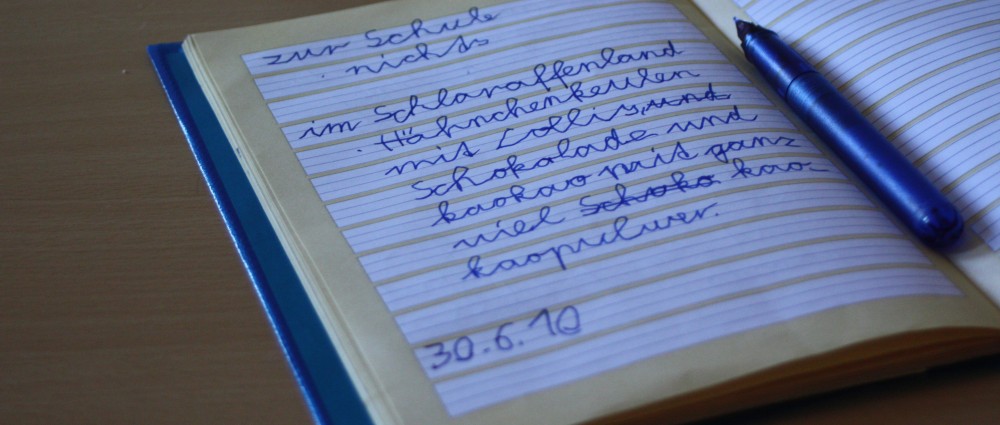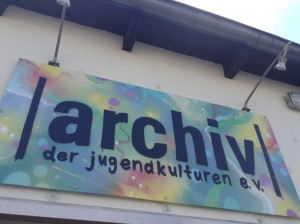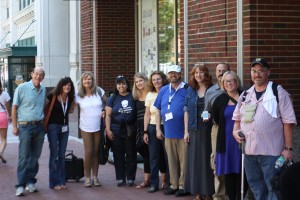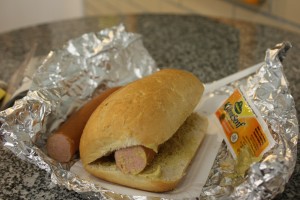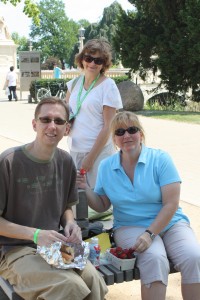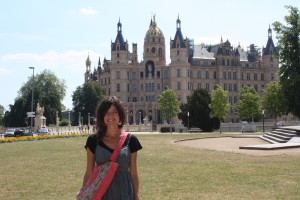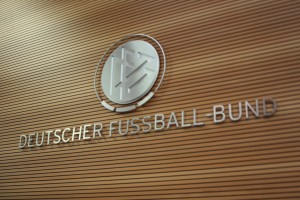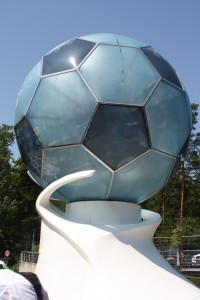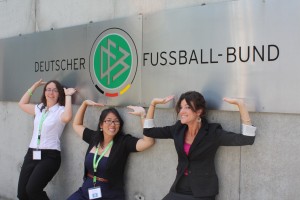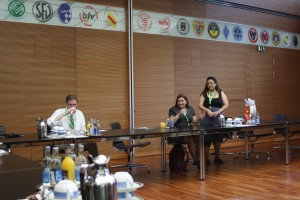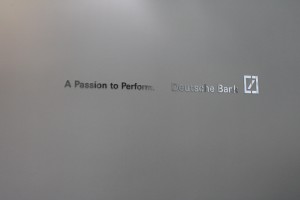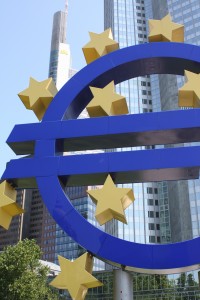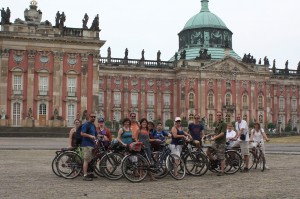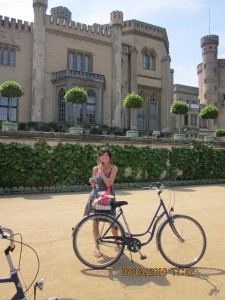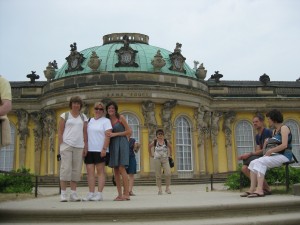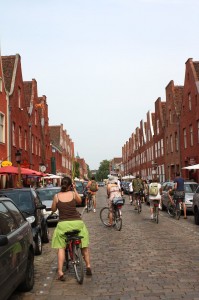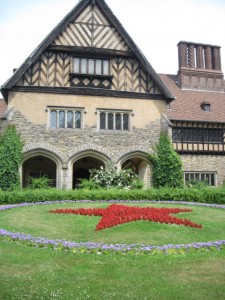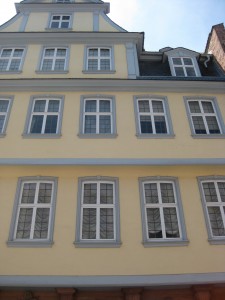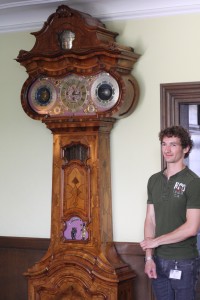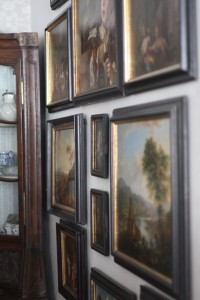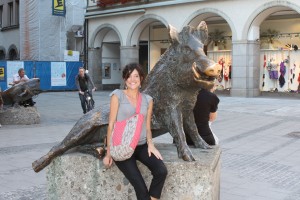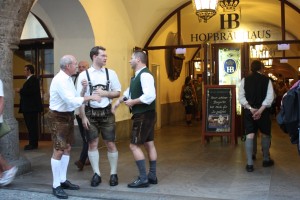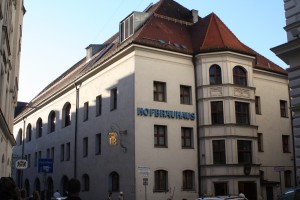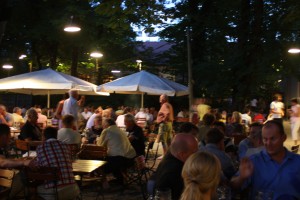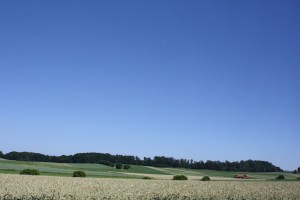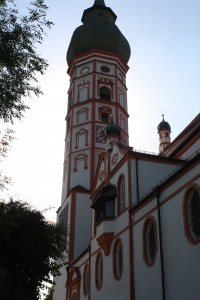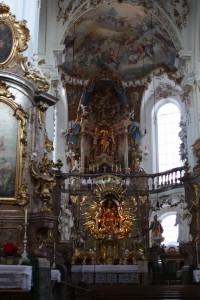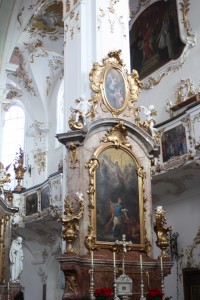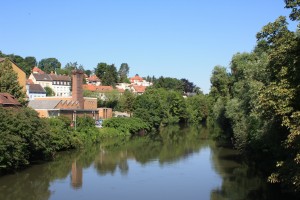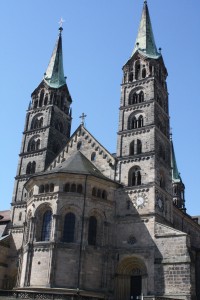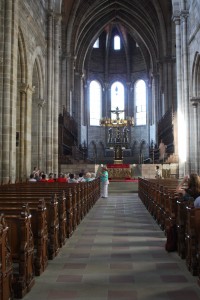New Faces
So, blogging in Berlin was hard! With all of the World Cup matches (nail-biters!) to watch and celebrations to be had in the evenings, reflecting on the days’ events happened, but not within this blogging venue. Now that I am home and back in school mode, it’s time to capture some of those moments. Our appointments were relevant to our research, and the people we encountered left a lasting impression, providing a more meaningful experience for us to take back with us. To follow up with my most recent post, I wanted to summarize what we learned during our visit with Ms. Gabriele Rohmann, who is the Project Manager of New Faces. This was our first appointment in Berlin. The first thing I noticed when we arrived at the Cultural Archive building was the intriguing graffiti art that filled the entire side of one of the buildings in the courtyard there.
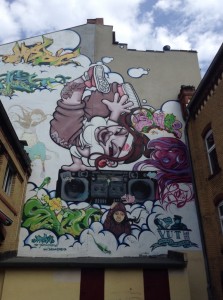 Ms. Rohmann greeted us and we quickly began to learn about the objectives that are implemented with the help of this program.
Ms. Rohmann greeted us and we quickly began to learn about the objectives that are implemented with the help of this program.
First, New Faces serves as a mediator for various diverse groups and provides opportunities for the exchange of cultural diversity and the strengthening of intercultural competence. This project promotes recognition of diverse cultures, especially in dealing with current-anti-Semitism.
Second, it seeks to train others how to strengthening others’ perception and recognition of cultural diversity (in the context of youth culture interests) and also finds eligible young people from Israel and Germany who would be good candidates for the program.
The third objective is intergenerational awareness regarding anti-Semitism.
The project works with a range of different methods and approaches the topic of current anti-Semitism in an unbiased and non-threatening way. Archiv der Jugendkulturen collects various types of media and is really an an archive which can serves as a source of inspiration and means to connect with youth. The youth culture in Berlin is global and New Faces creates opportunities for students to cooperate and express themselves. Rap, comics, DJ-ing, theater, photography, video, and Graffiti Art are several of the many youthful activities that help New Faces connect with students regarding political education. Students are able to be creative and the objectives of the project are achieved. In the workshops, the different backgrounds, and various social and physical settings from which the students emerge are taken into account.
The best part was that Ms. Rohmann shared some of the final products of the various workshops, including videos and comic books, and it was really amazing to see how the students used these media tools to communicate a message of tolerance and acceptance and diversity. Many groups were able to present their products in a multimedia exhibition to the public, either in the school, or in other institutions in the area.
Some additional information we received during this meeting was that this project actually began as a non-government program, but the government of Germany has since given its support of this project. When asked if there have been less incidents of violence and bullying as a result of these workshops, Ms. Rohmann shared that the project was effective. The schools whose students participated in these workshops noticed a significant reduction in bullying and discrimination and religious intolerance.
Introductions
I started this blog in 2010 to chronicle the adventures of me (a teacher from Arkansas) who traveled to Germany on a study tour with the Transatlantic Outreach Program. The blog-posting ended, but the experience stayed with me. TOP has provided me with one of the most rewarding opportunities for professional growth and development and has left a long-lasting impression on me as an individual. I am truly so thankful to TOP for how it chooses to achieve its purpose.
So, now, starts a new chapter. Here I am in Berlin, four years after my initial study tour to Germany with a new focus this time. This time I am traveling with a smaller group of about 10 other educators from around the nation (last time it was 16). The format of the trip is to create one large piece of curriculum with several sub-units to fit into the larger scope. The concept we are dealing with is multi-culturalism and cross-cultural awareness. We are working in teams of 2 to create 5 separate lesson plans related to the following: Immigration, Youth in Germany, History, Sports and Leisure, and Labor. We are using culture as the lens by which to understand these topics. For example, how has immigration changed the culture of Germany (past and present?) What was, and is, and is to come in regards to immigration and how does that impact the culture of Germany? The idea is that this discussion of culture will ignite questions about what it means to be German, what it means to be American, how we understand our own culture and that of others and ultimately, how are these themes realized within our specific topics.
Our teams will visit the meetings we find most relevant while in Germany and also collaborate to do research in Berlin and Geisa. Tomorrow morning, we are visiting Projekt New Faces which is a project that works with young people and adults to combat tendencies toward anti-Semitism in an immigration society.
I will be updating this blog throughout the week to provide some insight into some of our conclusions and the process that brought us to those. But, this blog won’t be limited to the research aspect of our TOP Alumni because so many components make a great study tour. You will see those ramblings here too!
A video summary
Click here to view my video which captures more highlights of our fabulous tour.
#5: An unexpected treat
#4: FIFA Women’s World Cup
Again, a quick recap…
I’m compiling a list of memorable/favorite events or situations from this trip that I didn’t have time to write about while I was gone. Is this an excuse to keep talking about Germany? Maybe! Nevertheless, I continue with #4:
Perhaps one of the most exciting things for all of us was getting to watch Germany play in three World Cup soccer matches and be there to celebrate along with them! This video describes it better than I can.
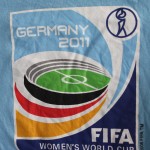
This t-shirt was one of the gifts we received when we visited the Deutscher Fussball-Bund. It has the logo for the Women's World Cup 2011.
Anyway, the day after we watched Germany vs. England from the streets of Frankfurt, we were scheduled to meet with the organizing committee for the Women’s World Cup 2011. Mr. David Noemi led our discussion, and it we all agreed that it was really cool to be there the day after a fussball victory for Germany! We learned about the goals of this organization (just to name a few):
- to build anticipation for the FIFA Women’s World Cup 2011
- to present themselves as cheerful, cosmopolitan and hospitable in the first Women’s World Cup to be held in Germany
- to write their own history of 2011
- to clearly express the integrative power of football for society
- to organize an environmentally friendly event
- to fill the stadiums, AND
- to strengthen the importance of girls’ and women’s football in Germany and around the world.
Here are some more pics from our FIFA visit. It was from here that we got on a bus and headed to Schwerin.
Deutsche Bank (Top 5 list continued)
I decided to divide my top 5 into different posts, since some of these might be longer than others. So, in case you lost track…Here’s my list so far:
1. Potsdam Bike Tour
2. Goethe House
(Remember these are not in any particular order, although the next couple things happened to take place in Frankfurt)…..
3. Deutsche Bank
I wanted to share more information about our visit to the Deutsche Bank offices, which I mentioned in one of my earlier posts, but didn’t go into great depth. This was our very first official meeting of which we were required to wear our formal business attire. After two days of no sleep and fussball watching, we cleaned up nicely!
The Deutsche Bank, is one of the main sponsors of the Transatlantic Outreach Program, so we were looking forward to hearing all about it. Aside from it being one of the most global banks, made up of employees from 140 nations, The Deutsche Bank also plays an important role as a corporate citizen. In other words, its goal is
- to create opportunities for people through social investments,
- to encourage creativity by getting involved in art and music,
- to inspire talent through its educational program,
- to be a role model of sustainability by protecting our environment and conserving resources,
- to provide opportunities for its employees to volunteer in their local community.
Since I don’t understand a lot about investments and financial industry, I was pleased that this meeting was about more than money. We learned about the history of the Deutsche Bank (founded in Berlin in 1870) as well as their standards for creating a “Green Building” for their new headquarters. Their new building will have windows that can be opened or closed, to provide a more efficient air-conditioning system. In addition, the building’s technology will prevent heat from escaping when it’s cold outside. Their new building will also warm 50% of the water with solar energy. Purely by using rainwater collected on the roofs, 15% of freshwater will be saved. The building will also use daylight to light certain spaces of the offices and use energy saving lighting technology in order to reduce overall power consumption! For example, a glass ceiling will flood the foyer with daylight. I’m excited for the TOP participants that will get to see this new “Green Building” in future study tours. This was definitely one of my favorite presentations. It was truly inspiring to hear about such a huge corporation that is setting the standard not only for an environmentally-friendly headquarters, but also making social investments that might help people overcome unemployment and poverty.
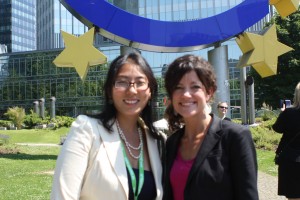
In this photo, we had just finished with our meeting at the Deutsche Bank. We stopped here for a group photo in front of the European Central Bank. The symbol behind us represents the Euro, which is the official currency of the European Union. After this, we head to the Deutscher Fussball Bund for a meeting with the organizing committee for the Women's World Cup 2011!
Top 5 of TOP 2: Stuff I haven’t mentioned yet!
Okay, so, when I was traveling in Germany from place to place, sometimes it was difficult to a) find the time, and b) find affordable internet service in order to continue posting on this blog! So, needless to say, there are some events/situations that are worth mentioning about our fabulous study tour with the Transatlantic Outreach Program. I have narrowed this list down to 10 of my favorite things that I left out! Here they are in no particular order:
1. Potsdam: bike tour
Who would have thought that I could go on a bike tour in Potsdam, Germany, which would include visiting the residence that hosted Potsdam conference of 1945, seeing palaces & eating ice cream, and even a little “swimming”? This day was truly one of the most memorable and unexpected, to say the least. Some events on this tour were more unexpected than others! I digress. Potsdam is famous for the post-WWII talks between U.S. President Harry Truman, the USSR’s Joseph Stalin, and Great Britain’s Clement Attlee. At this conference, tension increased between the United States and the USSR. It also served as a possible forewarning to the Cold War era.
2. Goethe House
Our tour of the birthplace and home of Goethe was overshadowed by the other events of our first day in Germany (attending a high Catholic mass at the biggest church in Frankfurt, eating my first *real* frankfurter, and watching Germany beat England in the World Cup and the celebrating that followed). Not to mention, I felt this mixture of “I’m so excited we’re here, let’s push through and fully experience every minute….to, hmmm, I think I need to lie down here for *just a minute* and take a power nap.:) The Goethe House was not forgotten, though…no, no it wasn’t! As you can see from the photo, the Goethe House has 5 levels, 4 of which we toured every room. Johann Wolfgang von Goethe (1749-1832) was a German writer and is considered by many to be the most important writer in the German language and one of the most important thinkers in Western culture. Goethe’s literary works include numerous poems and novels, but he is most famous for Faust. Here are some more photos from this famous author’s home.
Munich highlights
Ah, Munich. After arriving, we freshened up, and then headed to the city center of Munich. One of the first things I saw was a statue of what our guide called a “wild boar”. Since it looked a Razorback to me, I had my friend snap a photo of me sitting with him!
The culmination of our tour was spent touring Munich: seeing the sights, tasting more Bavarian food, and enjoying each other’s company. Some of the spots we were sure to hit:
1) Hofbräuhaus
I had never heard of this place before, but apparently it was a place we had to experience! Our guides warned us that we would see more Americans and other tourists here than in any other place we had been, and they were right. The Hofbräuhaus could be fairly called *the* number one tourist attraction in the Munich city center. This place is everything that Bavaria is all about. (i.e. long wooden tables and benches. Drinks are served in 1 litre sized glasses. Giant pretzels on sale and an ompah band playing traditional Bavarian brass band music.) Although I was underwhelmed by this theme-park-ish, touristy, restaurant, I am glad we went. Here’s a pic of the outside of the restaurant, complete with guys dressed up in their traditional Bavarian lederhosen.
2. Olympic Stadium in Munich
A small group of us visited the place where the 1972 Summer Olympics were held in Munich. These games were the second Summer Olympics to be held in Germany, after the 1936 Games in Berlin, which had taken place under the Nazi Regime. Mindful of the connection, the West German Government was anxious to take the opportunity of the Munich Olympics to present a new, democratic and optimistic Germany to the world. However, the Games were overshadowed by what has come to be known as the Munich massacre. On September 5th, a group of eight Palestinian terrorists broke into the Olympic village and took eleven Israeli athletes, coaches and officials hostage in their apartments. Two of the hostages who resisted were killed in the first moments of the break-in.
3. Augustiner Keller
I can’t talk about the culture of Bavaria without mentioning the concept of the biergarten. Basically, a biergarten is an open-air area, where beverages and local food are served. The concept originates from and is most common in Southern Germany, especially Bavaria, and in places like Munich, one may serve large numbers of customers. Many people bring their own food in and just buy drinks. This one in Munich had a band which covered songs we knew from the 70’s, 80’s and 90’s. Fun!
band playing at Augustiner Keller in Munich
4. Andechs Monastery
With its brewery, Bräustüberl, monastery restaurant, and monastic pilgrimage church, Andechs is a very sought after meeting place attracting visitors from around the world. Located at the top of the “Holy Mountain” in the middle of Upper Bavaria’s Five-Lakes Region, Andechs Monastery is visible from far away. Here are some pics I took from inside the bus on the way to the monastery! Gorgeous!
In 1846, King Ludwig I of Bavaria bought Andechs Monastery and presented it as a working farm to the Munich Benedictine Abbey, St. Bonifaz, which he had recently founded.
The monks of the oldest monastic order, The Order of St. Benedict, of the Catholic Church, have done a lot for the spread of the Faith and the cultivation of Europe in the course of the centuries. Their monasteries were not only the places of prayer concentrating on a life devoted to God, but were also centers of learning and art.
We learned about the interior of the church hall, which is a Gothic hall church dating from the early 15th century and decorated with rich colors of mid-eighteenth century Rococo. (also referred to as “Late Baroque” because Baroque artists gave up their symmetry and became increasingly more ornate. Rococo rooms were designed as total works of art with elegant and ornate furniture, small sculptures, ornamental mirrors, and tapestry complementing architecture, reliefs, and wall paintings.) Here are some examples of how the Gothic and Rococo styles are intermingled inside this monastic church.
Bamberg
Yesterday, we took a brief tour of Bamberg, which is a representative example of an early medieval town in central Europe. This town is famous for its artistic heritage, and its buildings have been so well-preserved. During its period of greatest prosperity, from the 12th century on, the architecture of Bamberg strongly influenced northern Germany and Hungary. In the late 18th century, it was the center of the Enlightenment in Southern Germany with the philosopher George Wilhelm Friederick Hegel and the writer and composer E.T.A. Hoffman both living there.
On our tour, we had the opportunity to go inside the cathedral of St. Peter and St. George, which combines the late Romanseque and early French-Gothic styles. Here are some photos of the cathedral.
I wish we could have stayed longer in Bamberg! Today, we tour Munich and in the afternoon we head to Kloster Andechs, a Benedictine abbey of Andechs. Andechs Abbey is famous for its Baroque church (1712) and its brewery.
